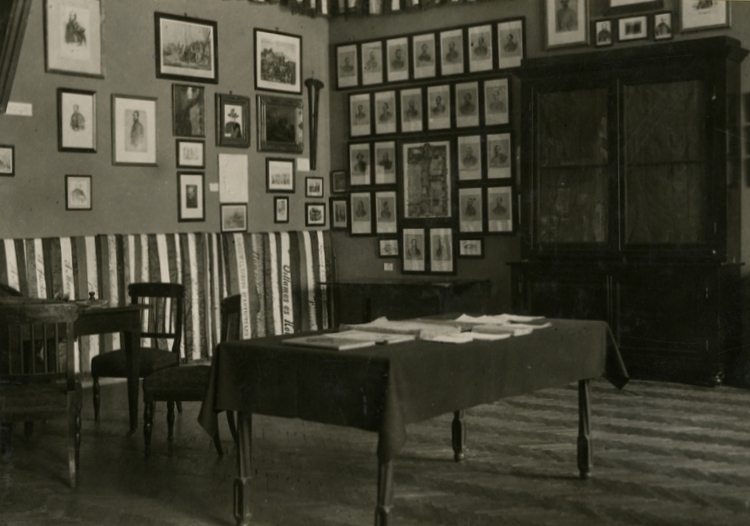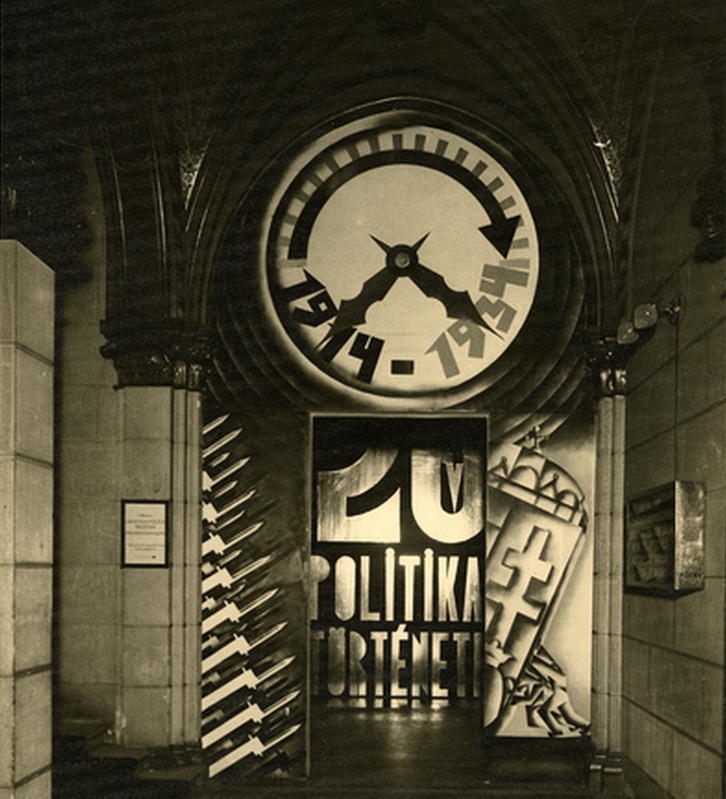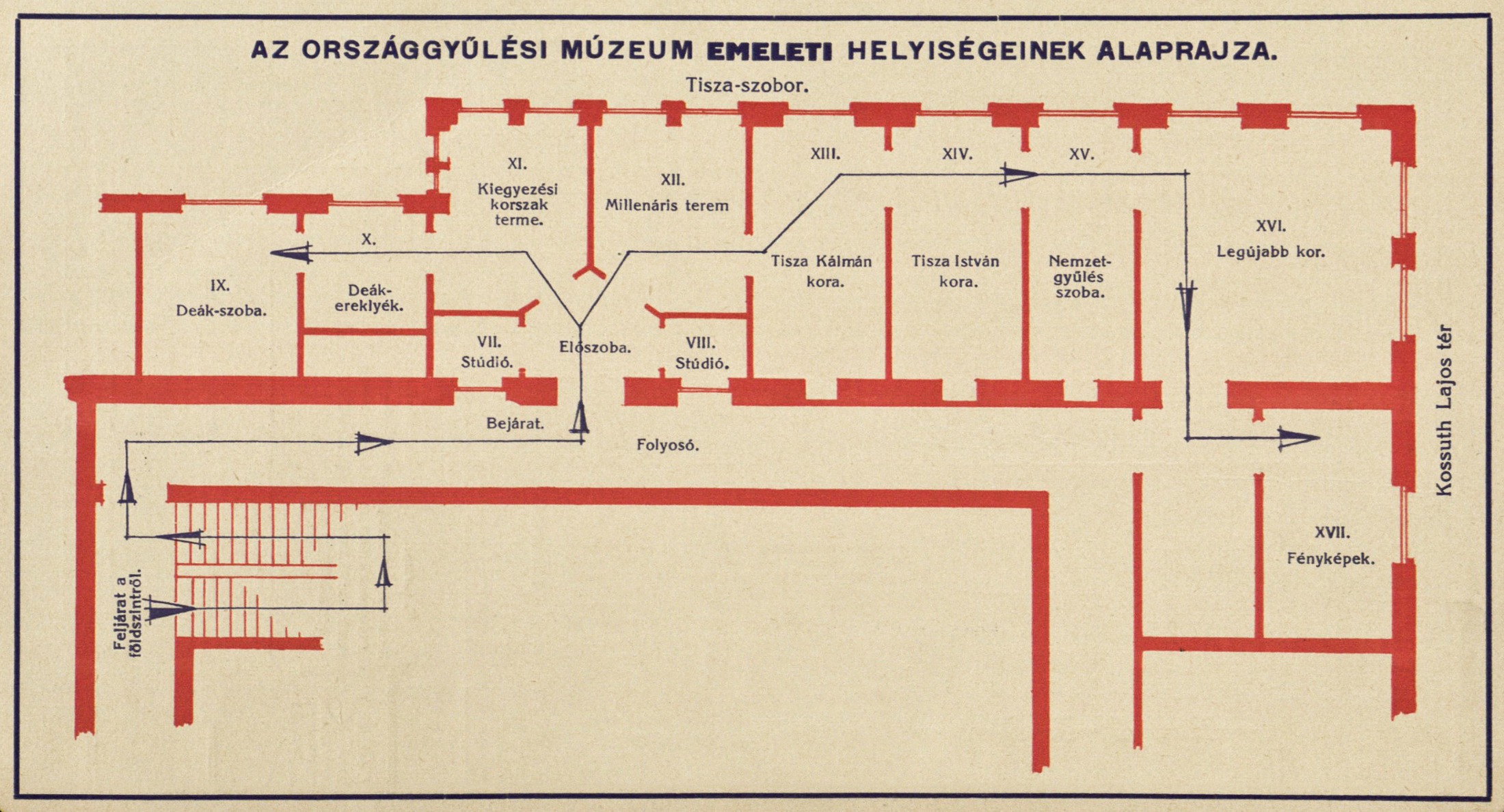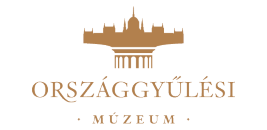A régi Országgyűlési Múzeum
A régi Országgyűlési Múzeum
Az Országgyűlési Múzeumot 1923-ban hozták létre, a magyar „parlamentarizmus és ezeréves alkotmányosság” történetének megőrzésére. Népszerűségéhez nagyban hozzájárult munkatársainak színvonalas, folyamatosan megújuló munkássága, de szerepet játszott benne a múzeum kiemelt politikai és anyagi támogatottsága és központi elhelyezkedése is. A II. világháborút követő kommunista hatalom a gyűjteményt felszámolta, a múzeumot pedig megszüntette.
A múzeum alapítása
Az I. világháborút követően a Bethlen-kormányzat úgy döntött, hogy a rendkívül súlyos mértékű államháztartási deficit ellenére teret enged egy új múzeum létrehozásának. Ennek első lépéseként a nemzetgyűlés 1922-ben, Scitovszky Béla házelnök kezdeményezésére 100 ezer koronát szavazott meg az Országgyűlési Múzeum kialakítására, melynek alapjául a Magyar Nemzeti Múzeum Deák-szobájának kiállítási tárgyai szolgáltak.
A múzeum ünnepélyes megnyitója
Az Országgyűlési Múzeum szervezése, gyűjteményének összeállítása és megnyitása a háború utáni súlyos gazdasági és pénzügyi viszonyok következtében rendkívüli módon elhúzódott: végül 1929. január 24-én, az Országház északi szárnyában, hét teremben nyílt meg hivatalosan a látogatók számára.
Gyűjteménye ekkor röpiratokból, plakátokból, képzőművészeti alkotásokból, fényképekből és használati tárgyakból állt.
1933-ban a múzeumot tizenhét helyiségre bővítették, és gyűjteményét jelentősen átrendezték.
A múzeum állománya folyamatosan bővült a beérkező ajándékokkal, híres politikusok és államférfiak hagyatékaival, valamint rendszeres vásárlással. Öt évvel később, 1938-ban már 24 terme volt, így kapott külön szobát Apponyi Albert és Klebelsberg Kunó is.
Az állandó kiállítás mind megjelenésében, mind tematikájában illeszkedett a Horthy-kor szellemiségéhez. Zsitvay Tibor meghatározása szerint az új múzeum feladata pozitív példákon keresztül bemutatni a magyar alkotmányos fejlődést, így bizonyítva, hogy a nemzet nem veszett el a területi elcsatolások után sem.
Igazi sikertörténet
A múzeum legsikeresebb korszakát a harmincas évek közepétől élte: látogatottsága és népszerűsége alapján a Nemzeti Múzeum és a Szépművészeti Múzeum után a harmadik helyre sorolták. Sikeres időszaki kiállításai mellett ezt annak köszönhette, hogy 1931-től nem kellett belépti díjat fizetni, továbbá a falai között szervezett szakmai előadások és vezetések is díjmentesek voltak.
A nagy sikerhez hozzájárultak az intézmény rendkívül népszerű időszaki kiállításai is:
- A Magyar politikai karikatúrák 100 éve
- 20 év politikai története 1914–1934
- Kossuth Lajos emlékkiállítás
- Rákóczi emlékkiállítás
- Alkotmánytörténeti kiállítás
- A választójog története
- 10 év politikatörténete
- Országgyűlések a XVIII. század fordulóján
- Széchenyi István a magyar országgyűléseken
A korszakban az Országgyűlési Múzeumban egyedülálló módon használták a modern technikai újításokat; egy-egy kiállítási rész tematikájához kapcsolódva filmvetítéseket, forrásértékű gramofonfelvételeket mutattak be. A múzeum munkatársai komoly gondot fordítottak arra, hogy élő politikusokkal és családtagjaikkal, különböző társadalmi és politikai szervezetekkel, szerkesztőségekkel, a Magyar Távirati Irodával és a Magyar Filmirodával, valamint riportfotográfusokkal is állandó kapcsolatban álljanak.
A hanyatlás időszaka
A múzeum 1942 szeptemberében a háborús viszonyok miatt határozatlan időre felfüggesztette a látogatást. A műtárgyak zömét a légitámadások okozta károk elkerülése végett a parlamenti pinceraktárakban helyezték el. A II. világháború során sok műtárgy eltűnt, megsemmisült vagy jelentősen megrongálódott. A kárfelmérést nehezítette, hogy a cédulakatalógus jelentős része is áldozatául esett a pusztításnak.
Az ostrom következményeként az intézményt a korábbi formájában megnyitni már nem lehetett, ám az anyaggyűjtés egy ideig a múzeum munkatársainak köszönhetően nem állt le. Ekkor kerültek a gyűjteménybe az 1945. és 1947. évi parlamenti és törvényhatósági választások röpiratai, propagandaanyagai, és a korszak politikusainak fotói. Dokumentumokat, műtárgyakat kölcsönöztek más múzeumok számára; 1948-ban például a Nemzeti Múzeum 1848-as centenáriumi kiállításán az Országgyűlési Múzeum több mint hetven műtárggyal szerepelt. A kommunista hatalomátvételt követően a Népköztársaság Elnöki Tanácsa 1949. szeptember 28-i határozatával felszámolta az intézményt; gyűjteményét, költségvetését és munkatársait november 1-jei hatállyal a Magyar Nemzeti Múzeumba helyezte át. Még az átadás előtt, az országgyűlés elnökének engedélyével 22 – zömében a két világháború közötti időszak politikusait megformáló – bronzszobrot kivontak a múzeum gyűjteményéből; ezeket az Országház főkapuját díszítő oroszlánszobor újraöntéséhez használták fel.
A múzeum gyűjteménye az áthelyezéskor mintegy 16 000 darabból állt. Ezt politikai sugallatra, a Nemzeti Múzeum Tanácsának döntése alapján több múzeum, könyvtár és levéltár között osztották szét. Az országgyűlések történetére vonatkozó iratai, tárgyai részben visszaszálltak az alapításkor adományozó múzeumokra, részben – az akkori közgyűjteményi gyakorlat szerint – tárgytípusok szerint osztották szét őket. Ma, a Nemzeti Múzeum gyűjteményein kívül többek között az Országos Széchényi Könyvtárban, a Budapesti Történeti Múzeumban, a Ceglédi Kossuth Múzeumban, a Természettudományi Múzeumban és a Hadtörténeti Múzeumban is találhatók műtárgyak az egykori Országgyűlési Múzeum gyűjteményéből.
|
|
|
|
A régi Országgyűlési Múzeum igazgatói: dr. Hollós Bálint (b), Palmer Kálmán (k) és Lukács Gyula (j).
Forrás: Magyar Nemzeti Múzeum, Folia Archeologica, Nemzeti Újság
a_regi_orszaggyulesi_muzeum_jobb_hasab
Tudástár
Videók:
Cikkek:

Forrás: Magyar Nemzeti Múzeum

Forrás: Magyar Nemzeti Múzeum

Forrás: Magyar Nemzeti Múzeum

Forrás: Magyar Nemzeti Levéltár Országos Levéltára
Forrás: Magyar Nemzeti Múzeum
|
A RÉGI MÚZEUM IGAZGATÓI VOLTAK:
1923–1931: Palmer Kálmán, a múzeum szervezési feladataival megbízott elnöki tanácsos, a múzeum első vezetője 1931–1938: dr. Hollós Bálint 1940–1948: Lukács Gyula 1949. január–november: dr. Magó János |








